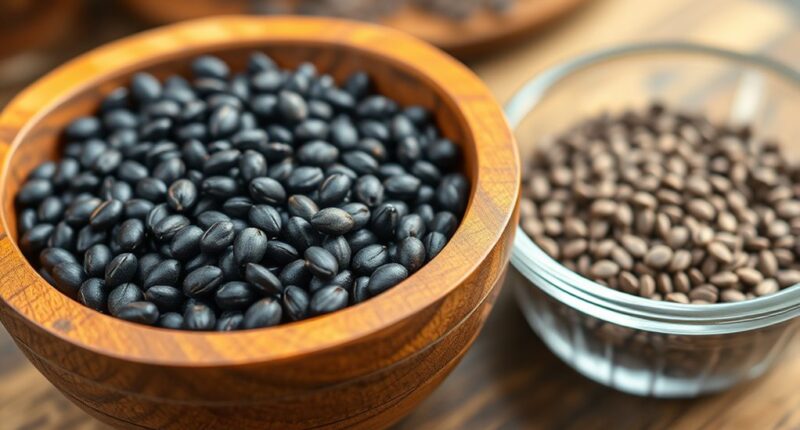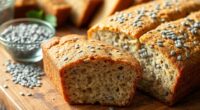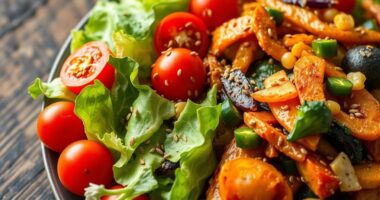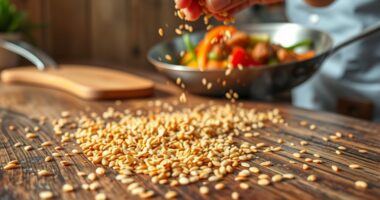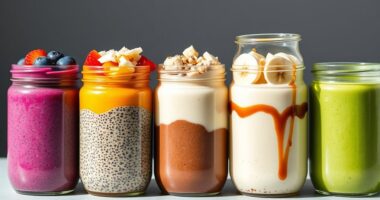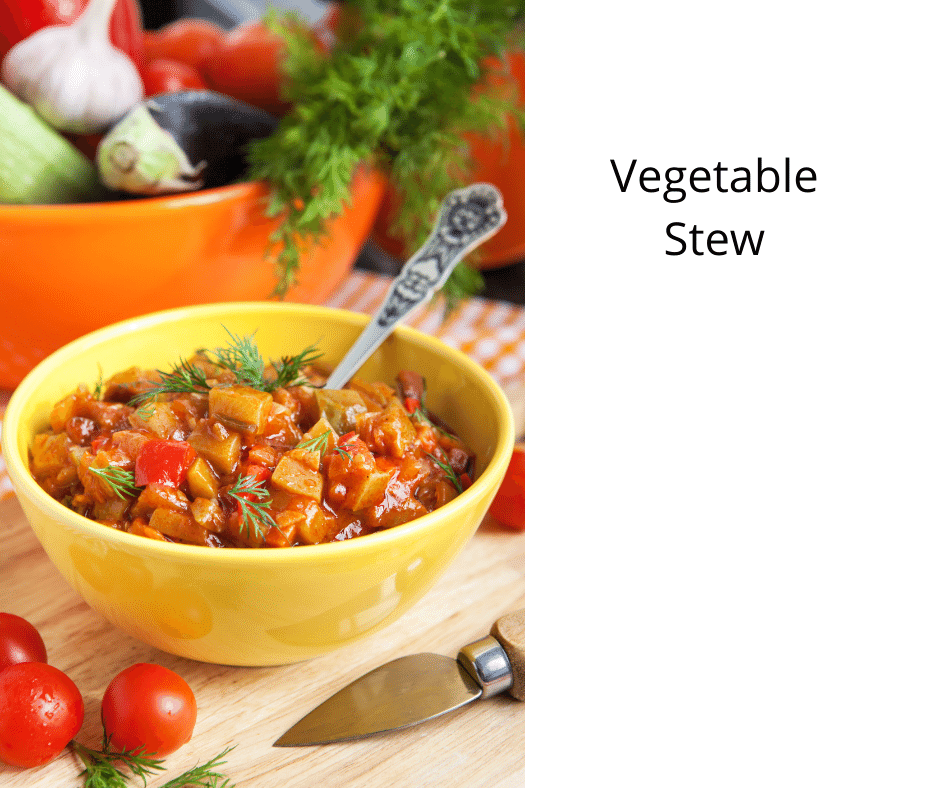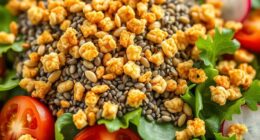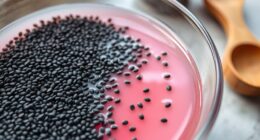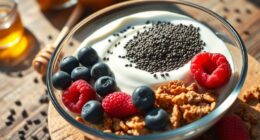Poppy seeds have a mild, nutty flavor that adds crunch and richness to baked goods, while chia seeds are neutral and mainly used for texture or thickening. Nutritionally, poppy seeds are rich in calcium, magnesium, and fiber, supporting bones and digestion, whereas chia seeds are high in omega-3s, fiber, and antioxidants, benefiting heart health and reducing inflammation. Want to discover how each seed can boost your dishes and health? Keep exploring for more details.
Key Takeaways
- Poppy seeds have a mild, nutty flavor, while chia seeds are neutral with a subtle texture.
- Nutritionally, poppy seeds are rich in calcium and magnesium; chia seeds excel in omega-3s and fiber.
- Poppy seeds add crunch and flavor to baked goods; chia seeds create gels and thickeners for smoothies.
- Chia seeds support heart health and reduce inflammation through antioxidants; poppy seeds aid digestion and bone health.
- Both seeds offer unique nutritional benefits and culinary uses, making them versatile additions to a balanced diet.

When choosing between poppy seeds and chia seeds, understanding their unique health benefits and culinary uses can help you make an informed decision. Both seeds pack nutritional punch and bring distinct flavors to your dishes, but they serve different roles in your diet. Poppy seeds are tiny, edible seeds derived from the opium poppy plant, and they have been used in baking and cooking for centuries. They offer notable health benefits, such as being a good source of dietary fiber, calcium, and magnesium, which support bone health and digestion. Their mild, nutty flavor makes them a versatile addition to baked goods, salad dressings, and even spice blends. Chia seeds, on the other hand, are small, black or white seeds from the Salvia hispanica plant, celebrated for their high omega-3 fatty acid content, fiber, and protein. These nutritional qualities translate into specific health benefits, such as promoting heart health, supporting digestion, and stabilizing blood sugar levels. Chia seeds are also rich in antioxidants, which help combat free radicals and reduce inflammation.
When it comes to culinary uses, your options differ based on the seed type. Poppy seeds tend to be used as a topping or filling, adding crunch and flavor to muffins, bagels, and roll desserts. They don’t absorb much liquid, so they’re often sprinkled on baked goods before baking or incorporated into crumb coatings. Chia seeds are more adaptable because they absorb liquids quickly, creating a gel-like texture. This makes them ideal for thickening smoothies, puddings, and oatmeal, or as an egg substitute in vegan recipes. They also work well as a crunchy topping when sprinkled onto yogurt or cereal. Because of their ability to form a gel, chia seeds can boost the nutritional profile of your recipes without altering taste much, whereas poppy seeds lend a distinctive nutty flavor.
Frequently Asked Questions
Are Poppy Seeds or Chia Seeds More Suitable for Baking?
When choosing between poppy seeds and chia seeds for baking, think about your desired flavor profile and nutritional differences. Poppy seeds add a nutty, slightly sweet flavor and a crunchy texture, perfect for muffins or bread. Chia seeds have a mild taste and are excellent for adding moisture and nutrition, especially in gluten-free or vegan baked goods. Both boost health, but pick based on flavor needs and texture preferences.
Can I Substitute One Seed for the Other in Recipes?
You can substitute one seed for the other in recipes, but keep in mind that substitution flexibility depends on flavor compatibility and texture. Poppy seeds add a nutty flavor and crunch, while chia seeds have a mild taste and gel-like consistency when soaked. If you want similar texture, chia can work as a thickener or binder, but the flavor may differ. Adjust quantities accordingly to achieve the desired result.
Do Poppy Seeds or Chia Seeds Have Any Allergenic Properties?
You might wonder if poppy seeds or chia seeds cause any allergenic concerns. While seed allergy concerns are relatively uncommon, some individuals may experience allergic reactions. Chia seeds could pose cross reactivity risks for those allergic to other seeds like sesame, while poppy seeds might trigger reactions in people sensitive to poppy seed allergy. Always check for allergy symptoms and consult with a healthcare professional if you’re unsure.
How Do Seed Prices Compare in Stores or Markets?
You might think seed prices are as steady as a rock, but market value and pricing fluctuations tell a different story. Poppy seeds often cost more due to their processing and legal restrictions, while chia seeds, though trendy, can vary wildly in price depending on the store or region. So, if you’re shopping smart, keep an eye out—what seems cheap today might spike tomorrow!
Are There Any Cultural or Traditional Uses for These Seeds?
You’ll find that both poppy and chia seeds hold cultural significance and traditional culinary uses. Poppy seeds often feature in baked goods like bagels and pastries in European and Middle Eastern cuisines, symbolizing prosperity. Chia seeds are valued in Central American cultures, used in drinks and energy bars for their health benefits. These seeds connect food with tradition, honoring history and cultural identity through their unique culinary roles.
Conclusion
When choosing between poppy and chia seeds, think about your flavor and nutrition needs. Poppy seeds add a subtle nuttiness, while chia offers a boost of omega-3s and fiber. Did you know that just two tablespoons of chia seeds contain about 11 grams of fiber? That’s more than a third of your daily recommended intake! So, whether you prefer the crunch or the health benefits, both seeds pack a powerful punch—perfect for elevating your meals.
